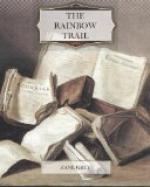He felt this, saw the old wildness with glad eyes, yet the greater part of his mind was given over to the thought of the unfortunate women he expected to see in Stonebridge.
Withers was harder to follow, to keep up with, than an Indian. For one thing he was a steady and tireless rider, and for another there were times when he had no mercy on a horse. Then an Indian always found easier steps in a trail and shorter cuts. Withers put his mount to some bad slopes, and Shefford had no choice but to follow. But they crossed the great broken bench of upland without mishap, and came out upon a promontory of a plateau from which Shefford saw a wide valley and the dark-green alfalfa fields of Stonebridge.
Stonebridge lay in the center of a fertile valley surrounded by pink cliffs. It must have been a very old town, certainly far older than Bluff or Monticello, though smaller, and evidently it had been built to last. There was one main street, very wide, that divided the town and was crossed at right angles by a stream spanned by a small natural stone bridge. A line of poplar-trees shaded each foot-path. The little log cabins and stone houses and cottages were half hidden in foliage now tinted with autumn colors. Toward the center of the town the houses and stores and shops fronted upon the street and along one side of a green square, or plaza. Here were situated several edifices, the most prominent of which was a church built of wood, whitewashed, and remarkable, according to Withers, for the fact that not a nail had been used in its construction. Beyond the church was a large, low structure of stone, with a split-shingle roof, and evidently this was the town hall.
Shefford saw, before he reached the square, that this day in Stonebridge was one of singular action and excitement for a Mormon village. The town was full of people and, judging from the horses hitched everywhere and the big canvas-covered wagons, many of the people were visitors. A crowd surrounded the hall—a dusty, booted, spurred, shirt-sleeved and sombreroed assemblage that did not wear the hall-mark Shefford had come to associate with Mormons. They were riders, cowboys, horse-wranglers, and some of them Shefford had seen in Durango. Navajos and Piutes were present, also, but they loitered in the background.
Withers drew Shefford off to the side where, under a tree, they hitched their horses.
“Never saw Stonebridge full of a riffraff gang like this to-day,” said Withers. “I’ll bet the Mormons are wild. There’s a tough outfit from Durango. If they can get anything to drink—or if they’ve got it— Stonebridge will see smoke to-day! . . . Come on. I’ll get in that hall.”
But before Withers reached the hall he started violently and pulled up short, then, with apparent unconcern, turned to lay a hand upon Shefford. The trader’s face had blanched and his eyes grew hard and shiny, like flint. He gripped Shefford’s arm.




